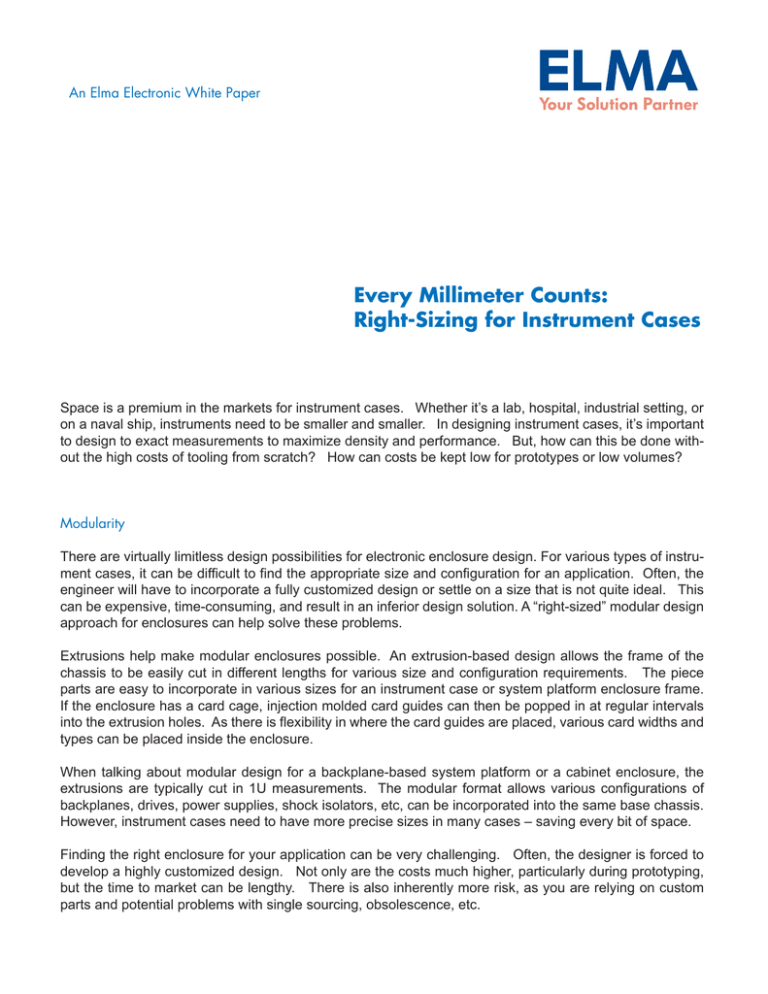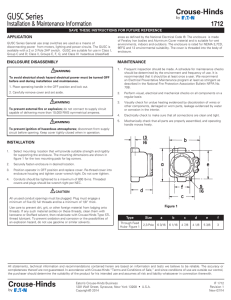
An Elma Electronic White Paper
Every Millimeter Counts:
Right-Sizing for Instrument Cases
Space is a premium in the markets for instrument cases. Whether it’s a lab, hospital, industrial setting, or
on a naval ship, instruments need to be smaller and smaller. In designing instrument cases, it’s important
to design to exact measurements to maximize density and performance. But, how can this be done without the high costs of tooling from scratch? How can costs be kept low for prototypes or low volumes?
Modularity
There are virtually limitless design possibilities for electronic enclosure design. For various types of instrument cases, it can be difficult to find the appropriate size and configuration for an application. Often, the
engineer will have to incorporate a fully customized design or settle on a size that is not quite ideal. This
can be expensive, time-consuming, and result in an inferior design solution. A “right-sized” modular design
approach for enclosures can help solve these problems.
Extrusions help make modular enclosures possible. An extrusion-based design allows the frame of the
chassis to be easily cut in different lengths for various size and configuration requirements. The piece
parts are easy to incorporate in various sizes for an instrument case or system platform enclosure frame.
If the enclosure has a card cage, injection molded card guides can then be popped in at regular intervals
into the extrusion holes. As there is flexibility in where the card guides are placed, various card widths and
types can be placed inside the enclosure.
When talking about modular design for a backplane-based system platform or a cabinet enclosure, the
extrusions are typically cut in 1U measurements. The modular format allows various configurations of
backplanes, drives, power supplies, shock isolators, etc, can be incorporated into the same base chassis.
However, instrument cases need to have more precise sizes in many cases – saving every bit of space.
Finding the right enclosure for your application can be very challenging. Often, the designer is forced to
develop a highly customized design. Not only are the costs much higher, particularly during prototyping,
but the time to market can be lengthy. There is also inherently more risk, as you are relying on custom
parts and potential problems with single sourcing, obsolescence, etc.
Right-sized Modular Design
A “right-sized” modular design can help alleviate these problems. For instrument cases, this process starts
with the aluminum extrusion, which are cut to any specified length. In many Eurocard system platforms,
the extrusion has a radius for sealing and gasketing purposes. In the instrument case solution in Diagram
1, the interlocking extrusions have a unique shape and design. See Diagram 2 The extrusion is designed
to accept tapped strips, sealing cords for EMC, optional direct mounting of a panel or PCB, grounding
terminals, or screws. This flexibility saves a few manufacturing processes, keeping costs low. Further, the
extrusion shape allows the extrusion and panels to be directly mated together. This prevents drilling and
tapping the extrusion, again saving costs. With a simple design and only a few pieces, the assembly can
be quick and easy. These cost advantages far exceed the extra cost of a super-functional extrusion. The
benefit to the designer is he can have an exact-sized case that is customized with a low cost – and in small
volumes. Typically, this kind of customization would only be cost-effective in high volumes. Now, it can be
done for prototypes and small volumes.
Diagram 1
A “right-sized” modular enclosure. The enclosure building blocks can be make to any length with the modular
extrusions, allowing precise sizes and configurations
with minimal customization efforts.
Diagram 2
An extrusion can be designed to accept panels and
covers, sealing cords, mounting panels, or various
terminals. This allows a great deal of flexibility in
the design and reduces assembly and customization
costs.
The extrusions do more than just allow a modular enclosure frame to be put together. An extrusion solution
can be designed symmetrically, so parts cannot be mounted incorrectly. The sidewalls, mounting panels,
or even PCB can be mounted directly into the extrusions, greatly reducing labor. Even nuts/bolts, grounding terminals, etc can fit right into a carefully crafted extrusion design.
EMC Considerations
EMC is an important consideration in enclosure design. It is an important part of a packaging designer’s
responsibility to ensure that the system does not interfere with, and is not susceptible to interference from,
other electronics equipment. Depending on the item’s usage, electronics equipment must meet compliance standards like FCC and CE. The goal is to create ground continuity over the outer skin of the enclosure and to block given wavelengths from passing through any openings. In order to ensure compliance a
wide range of issues must be considered. These include material type and thickness, conductive plating,
vent hole size, seam length, gasketing, power filtering, access panels and AC cable routing. To provide a
solid basis-point, the extrusions for the instrument case can be designed with 90-degree angles to cover
any open seams. Further, the shape of the extrusion can allow the insertion of EMC sealing cords.
Take the instrument case examples in Diagram 3b. The top and bottom extrusions as well as the front
panels have conductive connections (HF shield). This provides effective EMC protection. A further layer of
protection can be added with seals. This allows protection against splash and dust. As seen in the illustration in Diagram 3a, the top (and bottom) covers are folded over in the sheet metal stamping process. This
helps provide a tighter seal and boost the EMC protection of the unit. The typical attenuation in the electric
and magnetic field are shown in Diagrams 4a and 4b.
3a
3b
Diagrams 3a and 3b
EMC considerations can be built into the modular design. 3a shows how the covers fold over the edges
for EMC protection and 3b shows various configurations of assembled units.
4a
4b
Diagrmas 4a and 4b
An extrusion can be designed to accept panels and covers, sealing cords, mounting panels, or various terminals. This allows a great deal of flexibility in the design and reduces assembly and customization costs.
Adding Aesthetics
Aesthetics can be important in instrument case design. An attractive unit can set an OEM’s medical device
apart. There are several ways to enhance the appearance of a case including:
- bezels
- paint
- silkscreen
- swivel handle
- rounded corners
- aesthetic construction
The enclosures in Diagram 3b shows several units with various enhancements to their appearance. Actually, much of the aesthetics of this unit is inherent in the design. The rounded edges of the enclosure,
molded handles, and aesthetic construction are all part of the base platform design. Aesthetic construction
means design to minimize unsightly parts of the enclosure. For example, screws can be placed in hard-tosee locations, or the enclosure can be indented where the screws are placed to maintain a flat surface.
Also, cover panels and bezels can hide these areas as well as add to the appearance of the chassis in their
own right.
Universal Construction
There are other ways to achieve a high degree of modularity. Take the case in Diagram 5a. It has a universal construction with 4 front extrusions, 4 depth extrusions, and 4 vertical sections. This jigsaw approach
to the base platform allows a high degree of flexibility in the configurations that can be assembled. Diagram 5b shows a finished unit. A construction like this is ideal for particularly prototyping for Eurocard applications.
5a
Diagrams 5a and 5b
Modularity takes many forms.This design is
geared to provide a “universal construction” to
maximize flexibility.The piece parts (5b) and
assembled unit (5a) are shown.
5b
Assembly - Saving time
One very important area of packaging for instrument cases is the assembly time. Assembly is a variable
cost – and not something that should be overlooked. There are many ways to save time. First, a mounting
panel can be used to attach the PCB. This prevents the OEM from having to drill into the bottom of the
enclosure. The mounting panel easily mounts into the bottom of the enclosure and sits up about ¼ inch off
of the enclosure floor – allowing clearance for nuts, bolts, etc. For quick assembly time, the PCB can be
mounted to the mounting panel outside of the enclosure. Assembled outside of the case, the solution
provides easy access and less assembly time. Once complete, the case has sidewalls with grooves, so
boards can slide directly into the enclosure, without further mounting or customization. Further, the PCB
can be mounted to the front panel during assembly. This provides an extra secure mount and saves even
more time.
Going a step further, the “right-sized” enclosure in Diagram 1 has T-shaped grooves in the extrusion to
allow for very versatile mounting. This allows mounting panels to be loaded both horizontally and vertically
in the enclosure case. Therefore, all types of components (fans, power supplies, tubes, etc) can be
mounted without customization and with less assembly time. Further, the T-shaped grooves can allow
grounding terminals to be placed. This provides a quick and convenient way to have a secure connection
to ground.
Less Effort, Cost, and Risk
An extrusion-based solution will typically be a much more attractive enclosure. The finely machined parts
and aesthetics of the design often have a cleaner, more professional look than simple stamped sheet
metal.
Overall, these modular design techniques limit the effort, cost and risk of customization. In high volumes,
many of these costs can be overcome. However, a modular design allows customization to be more costeffective during prototyping and lower volumes.
Elma Electronic Inc.
Phone: 510.656.3400
Email: sales@elma.com
www.elma.com
Copyright © 2009 Elma Electronic Inc.
All rights reserved.


